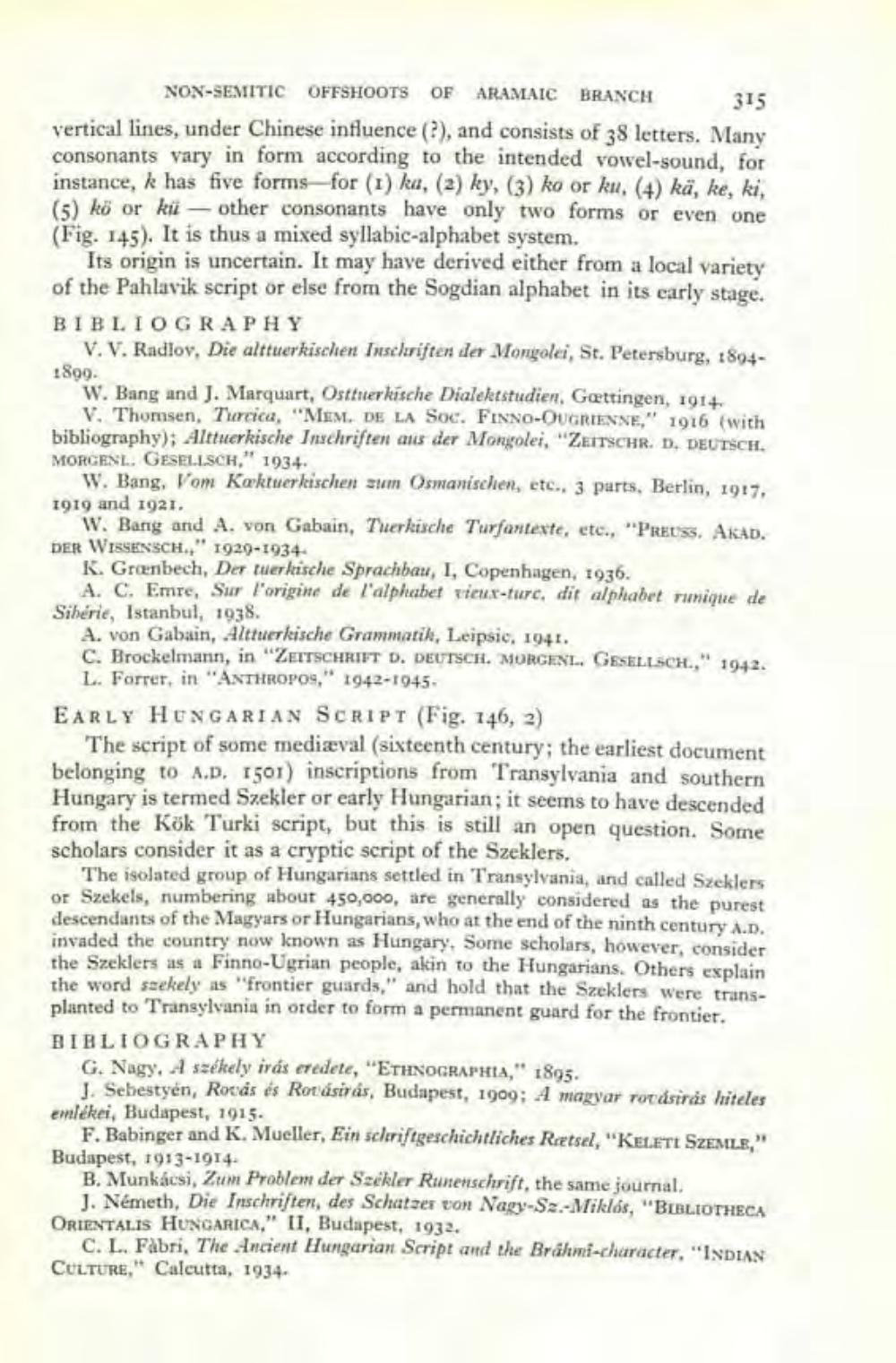________________
NON-SEMITIC OFFSHOOTS OF ARAMAIC BRANCH 315 vertical lines, under Chinese influence (), and consists of 38 letters. Many consonants vary in form according to the intended vowel-sound, for instance, k has five forms-for (1) ku, (2) ky, (3) ko or ku. (4) kä, ke, ki, (5) kö or kii — other consonants have only two forms or even one (Fig. 145). It is thus a mixed syllabic-alphabet system
Its origin is uncertain. It may have derived either from a local variety of the Pahlavik script or else from the Sogdian alphabet in its early stage. BIBLIOGRAPHY
V. V. Radlov, Die alttuerkischen Inschriften der Mongolei, St. Petersburg, 18941899.
W. Bang and J. Marquart, Osttherkische Dialektstudien, Gættingen, 1014.
V. Thomsen, Turcica, "MEM. DE LA Soc. FINNO-OUGRIENNE," 1916 (with bibliography); Alttuerkische Inschriften aus der Mongolei, "ZEITSCHR. D. DEUTSCH. MORGENL. GESELLSCH," 1934.
W. Bang, Vom Kaktuerkischen sum Osmanischen, etc., 3 parts, Berlin, 1917, 1919 and 1921.
W. Bang and A. yon Gabain, Therkische Turfantexte, etc., "PREUSS. AKAD. DER WISSENSCH.," 1920-1934
K. Greenbech, Der Tuerkische Sprachbau, I, Copenhagen, 1936.
A. C. Emre, Sur l'origine de l'alphabet vieux-ture, dit alphabet rumigue de Sibérie, Istanbul, 1938.
A. von Gabain, Alttuerkische Grammatik, Leipsic, 1941. C. Brockelmann, in "ZEITSCHRIFT D. DEUTSCH. MORGENL. GESELLSCH., 1942.
L. Forrer, in "ANTHROPO9, 1942-1945. EARLY HUNGARIAN SCRIPT (Fig. 146, 2)
The script of some mediæval (sixteenth century; the earliest document belonging to A.D. 1501) inscriptions from Transylvania and southern Hungary is termed Szekler or early Hungarian; it seems to have descended from the Kök Turki script, but this is still an open question. Some scholars consider it as a cryptic script of the Szeklers.
The isolated group of Hungarians settled in Transylvania, and called Szeklers or Szekels, numbering about 450,000, are generally considered as the purest descendants of the Magyars or Hungarians, who at the end of the ninth century A.D. invaded the country now known as Hungary. Some scholars, however, consider the Szeklers as a Finno-Ugrian people, akin to the Hungarians. Others explain the word saekely as frontier guards," and hold that the Szeklers were transplanted to Transylvania in order to form a permanent guard for the frontier. BIBLIOGRAPHY
G. Nagy. A székely irás eredete, "ETHNOGRAPHIA, 1895.
J. Sebestyén, Rosás és Rorásirás, Budapest, 1909: A magyar rovásirás hiteles emlékei, Budapest, 1915.
F. Babinger and K. Mueller, Ein schriftgeschichtliches Rätsel, "KELETI SZEMLE," Budapest, 1913-1914
B. Munkácsi, Zum Problem der Szekler Runenschrift, the same journal.
J. Németh, Die Inschriften, des Schatzer von Nagy-Sz. Miklós, "BIBLIOTHECA ORIENTALIS HUNGARICA," II, Budapest, 1932,
C. L. Fàbri, The Ancient Hungarian Script and the Brahmi-character. "INDIAN CULTURE, Calcutta, 1934.




